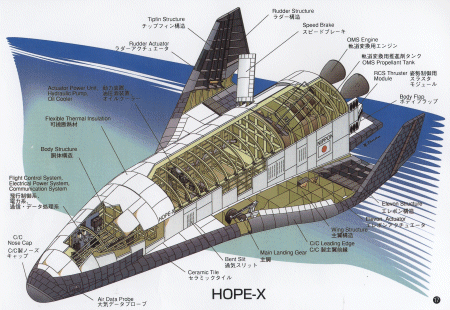Japan's HOPE X could be a technology springboard for future RLV programmes
Andrzej Jeziorski/TOKYO

Japan's efforts to develop future space transportation systems are three pronged. Alongside work to upgrade the nation's expendable launch vehicles and the development of reuseable launcher concepts, the National Space Development Agency (NASDA)and the National Aerospace Laboratory (NAL)have pursued a winged return vehicle, the H-IIA Orbiting Plane (HOPE).
According to senior NAL officials, about ´13 billion ($106 million) was spent on initial HOPE research from 1993 to 1996. Billions more have been allocated to the project since development started in 1997. Cost estimates to develop HOPE stand at about ´96 billion.
The aim is to develop an unmanned orbiter vehicle to be launched by an H-IIA rocket. It should carry a payload of 3-5t in a cargo bay designed to accommodate standard freight containers for the International Space Station (ISS).
NASDA envisages that HOPE could carry orbital experiments and observation equipment, as well as supplying the ISS. It would "expand the engineering base for future reuseable launch vehicle [RLV] systems by a step-by-step approach", according to a NASDA report to the International Astronautical Congress in Melbourne last year.
The project recently ran into trouble on two fronts, however. Engineers discovered that the wing configuration they had been working on - a delta platform with large wingtip-mounted fins - made HOPE too heavy. Sources close to the project say the structure at the junction of the fin roots and wingtips was particularly cumbersome, placing an unacceptable limit on the vehicle's payload. The worsening economic situation also squeezed the space budget.
As a result, the target of February 2001 to start flight tests of an experimental HOPE-X vehicle has slipped by three years and designers are working on a lighter configuration. The tip-mounted fins are to be replaced with a single, fuselage-mounted, tailfin similar to that of the NASA Space Shuttle.
According to NAL space projects and research centre director Nio Shinji, the new "trade-off configuration" should weigh about 10.5t empty (but will have a 20t take-off weight), with a 16m-long fuselage and a 10m wingspan. The structure will remain aluminium alloy-based, with some composite elements and ceramic heat-resistant tiles for re-entry.
Nio insists that the main reason for the delay was prevailing "financial conditions". In the interim, a ´9 billion budget has been allocated to build and test fly two quarter-scale demonstrators. These models will probe unconfirmed areas of the HOPE flight envelope: one for approach and landing, and one for transonic flight . Fuji Heavy Industries will build the models under a ´3 billion contract.
Preliminary design on the demonstrator models began in April. The landing regime model, Demonstrator 1, should fly late in 2001. Transonic flight trials on Demonstrator 2 are set for February-March 2002. According to the NAL, Demonstrator 1 will be powered by a Teledyne CAE 382-10 turbojet engine, weighing 68.5kg (150lb) and generating 45kN (10,100lb) of thrust. This vehicle will carry out automated take-offs and landings at NASDA's facility on the Pacific Island of Kiribati.
Tests, covering navigation, guidance and control systems, will be used to verify requirements for on-board and ground-based equipment at the landing site. Demonstrator 1 will fly at altitudes up to 39,000ft (12,000m ) and speeds up to Mach 0.7.
Demonstrator 2 will be launched either from a balloon, lifting it up to about 115,000ft, or from a Scaled Composites Proteus aircraft at 59,000ft, using a rocket booster to reach its maximum altitude. The demonstrator will accelerate to M0.8-1.2 in a glide, before recovery by parafoil. Nio says that possible test sites for Demonstrator 2 include Kiruna in Sweden, the USA's Mojave Desert, or Australia.
Other regions of the anticipated HOPE flight envelope have been tested by three precursor vehicles.
The first was the Orbital Re-entry Experiment (OREX), aimed at testing and gathering data on atmospheric re-entry. In 1994, the 865kg, capsule-type vehicle was launched into a 450km (280 mile) orbit by the first H-II rocket. Ground controllers took the vehicle out of orbit after one revolution of the earth, and conducted re-entry and splashdown.
The second precursor was the Hypersonic Flight Experiment (HYFLEX), a 1.07t, 4.4m-long, bullet-shaped vehicle with stub fins for stability. It was launched to 110km by a two-stage J-1 rocket in 1996, flying back to earth at Mach numbers from 14 down to 2. The vehicle was lost after splashdown when the lifeline tying it to a float broke.
In the same year, tests were carried out on an Automatic Landing Flight Experiment vehicle, which had a similar design to the earlier HOPE-X, with wingtip-mounted fins, and a microwave landing system. This 0.76t vehicle - about one-third the size of HOPE-X - was used for 13 successful automated glide approaches and landings at the Woomera runway in Australia.
When, and if, the HOPE vehicle becomes operational, the Japanese authorities plan to use it as a technological springboard to a bigger Japanese role in manned and unmanned spaceflight, perhaps most vividly illustrated by the NAL's ambitions to develop a scramjet-powered spaceplane.
It seems unlikely that Japan could undertake such a costly programme alone, but success with HOPE might make it a credible partner in an international spaceplane effort.
Source: Flight International























